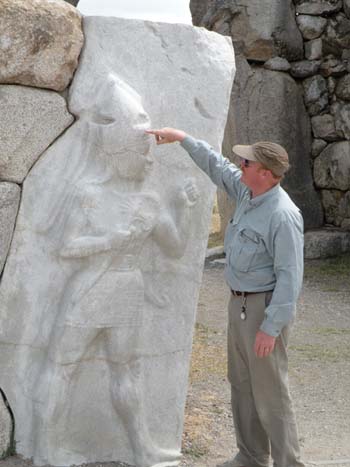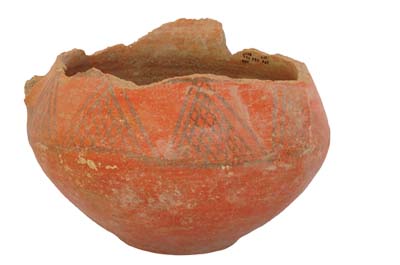 |
 |
| current issue |  |
past issues |  |
send a letter/news |  |
address update |  |
advertise |  |
about us |  |
alumni home |
Features
Buried TreasurePage 3 of 3
 HITTITE CAPITAL: History professor Gregory McMahon takes students on a tour of Hattu�a. He's fluent in written Hittite: 30,000 clay tablets found in Hattuša are the main source of Hittite literature. Above, McMahon points to a carving on the King's Gate.
HITTITE CAPITAL: History professor Gregory McMahon takes students on a tour of Hattu�a. He's fluent in written Hittite: 30,000 clay tablets found in Hattuša are the main source of Hittite literature. Above, McMahon points to a carving on the King's Gate.
|
This season, they do not find ceremonial tablets or a temple's foundation, but they do discover the lower half of a goddess made of lead from the middle Bronze Age, 1,000-year-old walls, a Byzantine ceramic oven that could have been part of a primitive community bakery, and a large stone block that may have been a manger or basin. They also unearth an abundance of pottery. Most of it is in shards, except for a spectacular find in the Chalcolithic trench, where they locate four identical cups that may have been made around 4,000-3,000 B.C. "Every time you stick your shovel in the ground, you find shards of pottery," McMahon says, "But it's very rare that you can recreate a total piece."
In the Byzantine trench, a millstone from the 11th century is unearthed. "It looks like a big flat stone with a circle carved into it," says Wellinghurst, who helped find the ancient tool. "It must have had a hand crank to grind the wheat."
Although this season's excavation did not reveal as many Hittite treasures as McMahon had hoped, it will provide new insight into the ancient mystery that pulls him back each year to Cadir Hoeyuek. "Archaeology is a cumulative process," McMahon says. "You uncover new parts of the puzzle every year. This year, we continued to excavate a large wall in the Byzantine trench. We're still trying to hypothesize what kind of building complex it could have been and what they used it for."
Regardless of the finds, McMahon relishes watching his students embrace life in a small Turkish village and the opportunity to learn how to search for and document primitive history. "They'll walk away with what I promised them," he says.

|
"They get to be part of a major archaeological team, living and working with scholars, seeing how they think and work," he adds. "And they get to experience a totally new culture, not just by visiting Turkey but by living among its people."
On a morning in August, McMahon and his students stow their luggage in a dusty blue minivan. A young village girl throws water onto their car, a Turkish tradition to ensure the visitors will return again. McMahon offers a Turkish good-bye given by departing friends: Allaha ismarladik ("We commend you to God.") The Turks reply with their own traditional farewell from those who are left behind: Guele. Guele. ("Go smilingly.") As McMahon leaves, he knows he will indeed return again to work with his colleagues, to revisit a village he has come to call home, and to dig for ancient treasures that lie beneath the dirt.~
Barbara Walsh '81 is a Pulitzer Prize-winning journalist in Maine. Page: < Prev 1 2 3
Easy to print version
blog comments powered by Disqus
